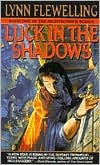Saturday, May 16, 2009
The Marshall Plan 4: Keeping Organized
In summary, here's how to keep yourself organized while using The Marshall Plan. At least, it works for me.
First, brainstorm on your own. Write lists, write descriptions, make notes, outlines, tables, flow charts, draw sketches, do whatever you need to in order to come up with ideas for your story. Organize your notes in your own way to develop a sense of the flow of events. When you have your story clearly in mind, the major events, the major characters, the progression of major scenes from beginning to middle to end, then take what you have learned about your story and...
Second, develop your action/reaction sections using The Marshall Plan. This will involve rethinking your story and nailing things down in considerable detail. Exactly what happens when, in what order. For each section, you'll have the choice of which character should serve as the POV character, and you'll be able to specify exactly what his/her goal is, who the opposing character is, the complication(s) that arise, and how this ends (failure for the protagonist, success for the antagonist). If it's a reaction section, you'll be able to identify exactly what emotions the POV character is experiencing, and the key ideas that he/she considers when making a decision of what to do next.
After I brainstorm, and write, rewrite and rewrite again my various notes, condensing things, keeping what's good, tossing the rest, I print them out and put them in a three-ring binder. They're right up front, where I can easily find them and refer to them while writing. Sometimes while writing I need to look up a character name in my list of characters, or remember some detail in the magic system, or refer to a map or time line, etc.
After the notes, I print out the section sheets on colored paper so they stand out, and put them in the binder. My section sheets are done in two columns. The right column contains a page-long table that lists the POV character, goal, opposition character, etc. The left column contains notes that describe the scene and list any additional ideas that I want to be sure to include when I write the scene.
Finally, as I write the manuscript, I print out the sections (typically 4-6 typed pages) and put them in the binder after their corresponding section sheets.
This helps me in a couple of important ways. First, by planning before writing, the burden of thinking up a story is removed from the writing process. I create, then I write. When I write, I can focus on the story and how best to dramatize it. I can refer to the section sheet for the current section and remember what I had dreamed up previously while planning. I can focus on just that section and reflect on how to write it, then write it. I stay focused, knowing clearly what I'm trying to accomplish, and how it fits in with the rest of the story. Second, I can easily find things by laying them out in a binder. The colored paper marks the start of each section. The notes are on top. Since I've mapped the entire story out, it's easy to make changes. If I change an important detail in one scene, I know immediately which other scenes will be affected, and I can go to them directly and make the necessary adjustments.
Being hyper-organized isn't for everybody, but I appreciate how it makes the job a lot easier, and how it keeps me on track. Scenes are so much easier to write when you've already imagined them, already thought your way through them, already planned for them. When you know what came before, and what comes next.
Next: The Marshall Plan Novel-Writing Software
But First: Here's my first 3-D film, which I made on the www.Xtranormal.com web site. You must be 18+ to view it!
Cheers,
Adrian
Subscribe to:
Post Comments (Atom)








No comments:
Post a Comment